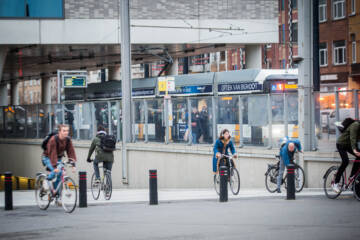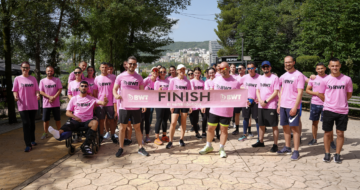HP’s three sustainable packaging strategies

Corporate social responsibility is the new hallmark for all modern businesses. For twenty years now, HP has been supporting numerous initiatives to work more sustainably. These initiatives are related to three different domains: people, society and the environment. One of the ecological initiatives being supported to stimulate the circular and CO2-neutral economy and to improve the customer experience, of course, is product packaging innovation.
Corporate social responsibility is the new hallmark for all modern businesses. For twenty years now, HP has been supporting numerous initiatives to work more sustainably. These initiatives are related to three different domains: people, society and the environment. One of the ecological initiatives being supported to stimulate the circular and CO2-neutral economy and to improve the customer experience, of course, is product packaging innovation.
Corporate social responsibility is the new hallmark for all modern businesses. For twenty years now, HP has been supporting numerous initiatives to work more sustainably. These initiatives are related to three different domains: people, society and the environment. One of the ecological initiatives being supported to stimulate the circular and CO2-neutral economy and to improve the customer experience, of course, is product packaging innovation.
By 2025, HP aims to achieve a 75 % reduction in disposable plastic packaging (compared to 2018). In order to achieve this goal, specific innovation projects have been launched, many of which were already completed by 2020. This resulted in 3,487 tonnes of CO2 emissions being avoided, partly owing to the fact that the sustainable packaging strategy in place focuses on three areas: elimination, innovation and circulation.
Elimination
HP endeavours to eliminate unnecessary packaging and hard-to-recycle materials such as plastic foam. In 2020, the sustainable technology partner shipped no less than 24 million personal systems in fibre packaging, avoiding the use of nearly 3,000 tonnes of hardly recyclable plastic. On the print side, 19 tonnes of plastic foam could be saved by removing the PET coatings from the LaserJet printer boxes. Also for accessories such as keyboards and desktop mice, measures were taken. The plastic straps were removed, saving a whopping 2,8 tonnes of polyethylene plastic and three tonnes of steel wire - materials that are extremely difficult to recycle and would otherwise end up in the dump.

Innovation
In addition to avoiding unnecessary packaging and materials that are difficult to recycle, HP is trying to improve the design and manufacturing process of fibre packaging by introducing 3D printing technology into the fibre industry. This allowed 73,000 products to be shipped with cushions made by means of 3D printing technology. HP also invested in bulk packaging, which implies that products are no longer packed individually in a box, but with several products together. In fact, no fewer than 217,000 desktops and 22,000 notebooks were shipped in bulk packaging in 2020, reducing the amount of packaging material by 65 tonnes. This also reduced the costs associated with shipping, storage and waste disposal.
Circulation
It is clear that HP favours materials with a high recycled content and easily recyclable materials because they can circulate smoothly. In 2020, the rollout of easily recyclable, fibre-based packaging cushions for notebooks, desktop computers and displays continued. The transition from plastic foam to fibre was pursued in 2021. Even the pallets are made from recycled material. In 2020, HP used 49,900 pallets made from straw originating from China that would otherwise have been burned up as agricultural waste – a recycling programme that will gladly be adopted in North America.
Of course, HP is taking many other environmental initiatives to be more sustainable. Find out more about them here.

Latest insights & stories

VERKEERSVEILIGHEID
Sinds 2018 is het aantal verkeersslachtoffers in Vlaanderen opnieuw gestegen. Momenteel stagneren de cijfers, maar het risico op ongevallen met letsels blijft groot voor kwetsbare weggebruikers in Vlaanderen. En dat terwijl het verkeer veilig moet zijn voor alle gebruikers en modi. We willen hier verandering in brengen door te focussen op transparant beleid, trainingen rond veilig gedrag, infrastructurele verbeteringen, wetgeving en handhaving.

Wat is er nodig voor een meer circulaire bouwsector? Inzichten van Sien Cornillie, expert circulariteit bij NAV
NAV, of "Netwerk Architecten Vlaanderen," is een professionele organisatie voor architecten in Vlaanderen. Ze biedt diverse diensten aan, waaronder professionele ontwikkeling en belangenbehartiging voor architecten. Daarnaast bevordert NAV ook netwerkmogelijkheden en geeft het advies over juridische, technische en managementaspecten. Het netwerk werkt momenteel aan een standpuntennota rond circulariteit. We spraken met Sien Cornillie, expert circulariteit bij NAV, die in dit interview uit eigen naam spreekt.

A Global Movement: The World Unites in a Pink Pledge for Clean and Sustainable Water
5,000 participants. 32 countries. €30,000 funds raised. And that's just the beginning.
Picture this: One step that sends ripples across the globe, transforming lives and creating waves of change. You might wonder, how can such a simple action for most of us have such a profound impact?